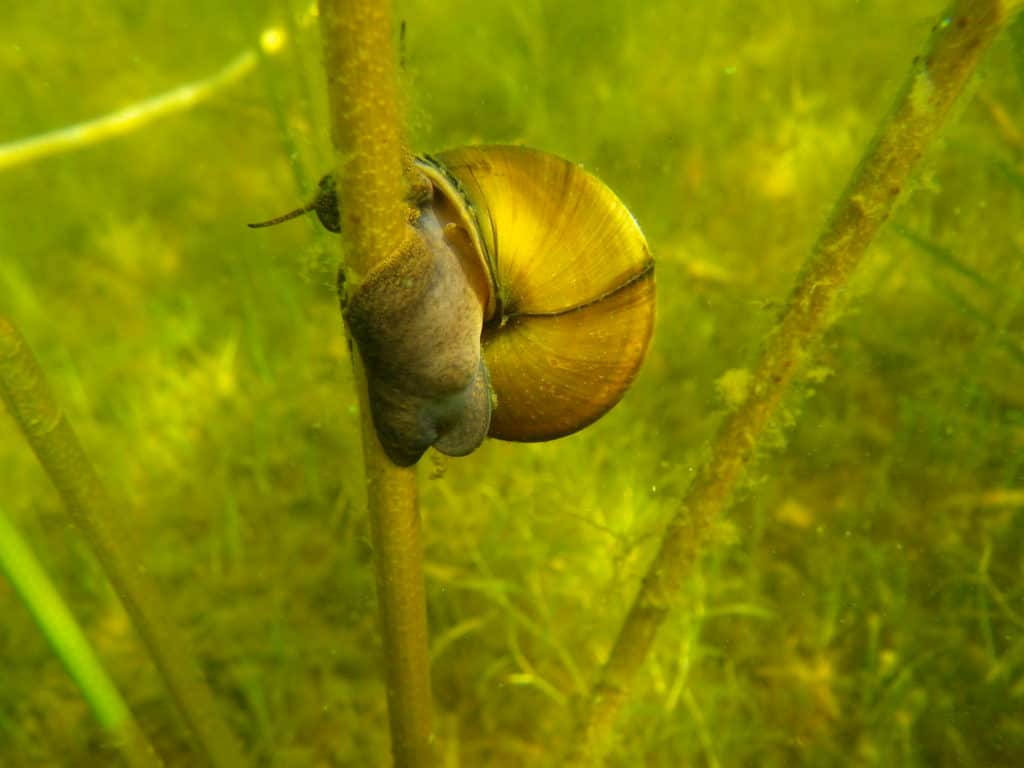[DISPLAY_ULTIMATE_SOCIAL_ICONS]
The snails can form dense populations, outcompeting native species for food and habitat in lakes and streams, disrupting the food web. They are also hosts for parasitic worms that kill ducks, geese, and other waterfowl. And dead snails can foul shorelines and beaches. There is no known way to get them out once they have infested a water body.
“They can survive out of water for days by closing their shells. Eradicating mystery snails is nearly impossible,” Minnesota Sea Grant says. “Your actions and your help in reporting new infestations are vital for preventing their spread.”
Native to Asia, Chinese mysterysnails were first shipped to California in the late 1800s for Asian markets, and then quickly appeared on both coasts. Their spread across the country is generally believed to be caused by release from aquariums and people who buy them from live food markets.
The species was first found in Minnesota in 1944, in the upper Mississippi River at St. Cloud, but was not recorded again until 1996. Then its territory exploded starting in the early 2000s, now infesting numerous lakes in the state and nearby states.
Mysterysnails have previously been found in northeastern Minnesota in Lake Vermilion, Swamper and Thompson Lakes near the Gunflint Trail, a few small Iron Range lakes. It is widespread in the Twin Cities area and northwestern Wisconsin.

Officials urged visitors to take responsibility for preventing the spread of non-native invasive species into the park. Of particular concern is preventing invasive species from spreading to the wild lakes on the interior of the Kabetogama Peninsula.
“The presence of a newly detected aquatic invasive species in Kabetogama Lake is a reminder that compliance with aquatic invasive species laws and recommendations to clean, drain, and dry watercraft and equipment is crucial in order to avoid spreading aquatic invasive species to new water bodies,” the statement reads. “It also underscores the importance of regulations and Best Management Practices in place to minimize the threat of spreading invasive species, now found in the large lakes of the park, to the fairly pristine interior lakes.”
The park’s management to protect the interior lakes includes requiring artificial bait, forbidding private watercraft (the park provides canoes and row boats for rent), and no float plane landings on interior lakes. The also ask visitors to interior lakes to bring a separate set of gear that is likely to contact lake water to use on the interior lakes, or make sure that all gear has been thoroughly dried for at least 5 days or washed with hot water (>140 degrees F) for at least one minute. When leaving lakes, remove aquatic plants from all gear.
Because most new findings of mysterysnails are thought be from aquarium disposal, practices for preventing their spread are focused on proper handling. From Minnesota Sea Grant, what you can do:
- Learn to recognize mystery snails.
- Contact a retailer for proper handling advice or possible returns.
- Give or trade with another aquarist, pond owner, or water gardener.
- Donate to a local aquarium society, school, or aquatic business.
- Seal aquatic plants in plastic bags and dispose in the trash.
- Contact a veterinarian or pet retailer for guidance on humane disposal of animals.
More information:

